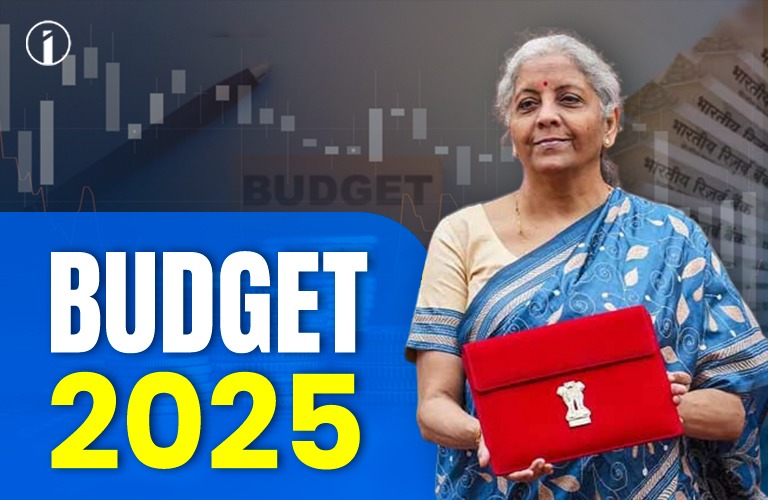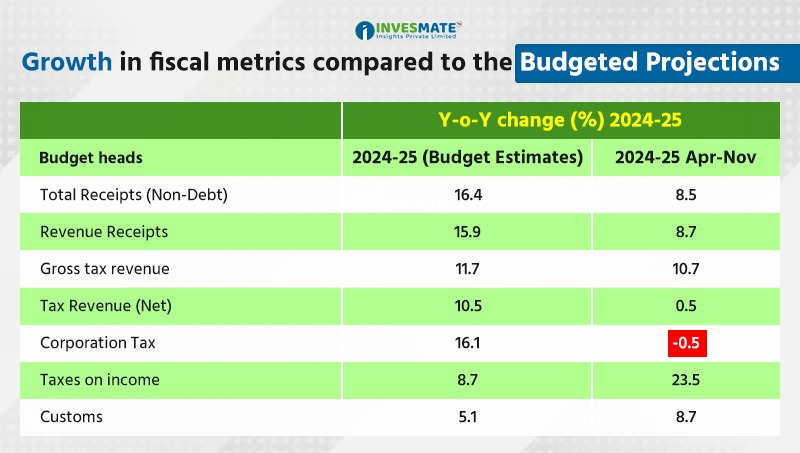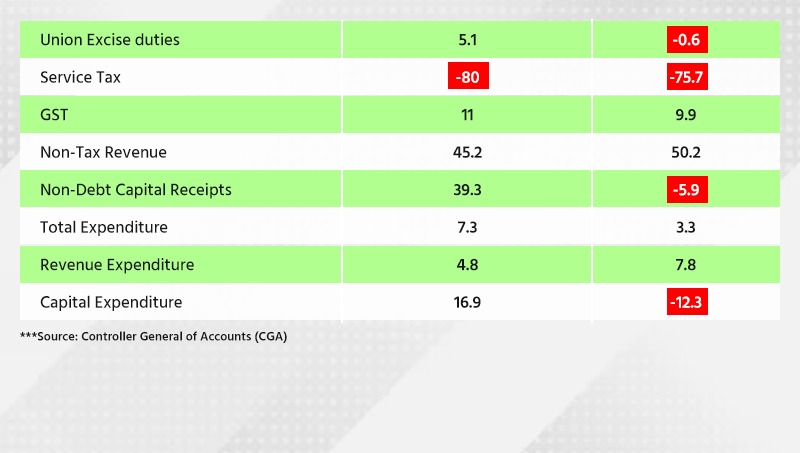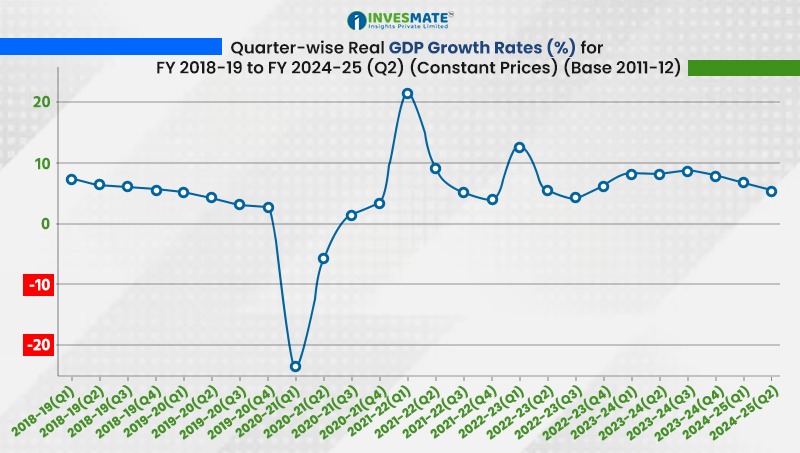![]()
1. Fiscal Performance Insights: Bridging Budget Expectations with Reality
The fiscal metrics for FY 2024-25 show mixed results. Income Tax outperformed with 23.5% Y-o-Y growth (vs. 16.1% target), but Net Tax Revenue grew only 0.5% (vs. 11.2% target), due to underperformance in Corporation Tax (-0.5%) and Union Excise Duties (-0.6%). GST grew 9.9%, slightly below the 11% target, reflecting economic challenges. Capital Expenditure plummeted to -12.3% (vs. 16.9% target), threatening infrastructure growth. On the positive side, Non-Tax Revenue grew 50.2%, exceeding the 45.2% target, though Non-Debt Capital Receipts fell -5.9% (vs. 39.3% target), highlighting disinvestment challenges. Immediate corrective action is essential to align fiscal policies with growth goals.
Policy Implications and Recommendations
- Enhance Corporate Tax Compliance: The decline in Corporation Tax collections must be addressed by improving compliance mechanisms and implementing targeted sectoral relief to boost corporate profitability. This would help stabilize tax revenues and improve overall fiscal health.
- Prioritize Capital Expenditure: The sharp contraction in Capital Expenditure requires immediate attention. Project timelines should be reassessed, and critical infrastructure sectors must receive adequate funding to ensure long-term economic growth and job creation.
- Leverage Non-Tax Revenue Gains: With Non-Tax Revenue exceeding targets, the surplus should be strategically utilized to offset deficits in tax revenues and fund essential development projects without compromising fiscal stability.
- Simplify and Streamline Tax Structures: Introducing measures to simplify the tax regime and incentivize compliance can encourage broader participation in the tax base. Policies should be aimed at reducing tax evasion and improving transparency across the system.
- Revitalize Non-Debt Capital Receipts: To address the underperformance in disinvestment and asset monetization, the government should expedite the sale of non-core assets and adopt innovative strategies for public-private partnerships to raise funds efficiently.
2. Tax exemptions in Budget 2025: Raising Exemptions and Expanding Tax Deductions
Current Challenges
The basic exemption limit and tax deductions have remained close to static over several years, failing to step up with inflation and growing costs of living. The deduction limits under Section 80C currently stand at ₹1.5 lakh, and Section 80D is ₹25,000 for all taxpayers and ₹50,000 for senior citizens, respectively, which is woefully inadequate for today’s financial realities.
Recommendations in Reform
Concessional corporate tax rates:
Raise the basic exemption limit under the new tax regime to ₹5 lakh from ₹3 lakh.
Raise the 30% tax slab threshold under the old regime to ₹21 lakh as against ₹10 lakh, inflation indexed.
Section 80C Deductions
Raise the limit of ₹1.5 lakhs to ₹2.5 lakhs which would cover an increased number of investments: ELSS, PPF, and NPS.
Health Insurance Deductions
These raise the existing ceiling under Section 80D from ₹50,000 for individuals and ₹70,000 for senior citizens to account for the inflationary rise in healthcare costs.
Effects of These Measure
These will affect on:
- Higher disposable income: Take-home salary for people would increase, thereby leading to consumption and demand.
- Induced savings: More deduction will enhance long-term planning and investments.
- Better Healthcare Accessibility: Increased health insurance deductions would mean lesser medical cost burden and better overall financial resilience.
3. Tax Slabs Overhaul: Keeping Up with Reality
Why It is Needed
Tax slabs have remained largely untouched since 2012, when the highest 30% rate came into effect for those earning over ₹10 lakh. In the context of rising salaries and inflation, this has disproportionately punished middle-income individuals.
Proposed Change in income tax slabs
Extend the 20% slab under the new tax regime to include the ₹15 – ₹20 lakh income range.
In case of the old tax regime, change the 30% tax rate, however only for income over ₹21 lakh.
What’s Positive
- Middle-class tax relief in Budget 2025: Much needed relief to middle-class taxpayers through the revised slabs would boost their spending potential.
- Promotion of New Regime: Wider slabs in the new regime would make it easier to comply and less confusing for taxpayers.
- Global Compatibility: Slab adjustments ensure India’s tax structure remains comparable to global peers.
4. Capital gains tax revisions: An Investment Catalyst
India’s capital gains tax is often viewed as cumbersome and complex, not encouraging long term investment. LTCG on equities is taxed at 10% and STCG at 15%. Hence, there is a growing call for simplification.
Recommended Reforms
- Standardize LTCG Taxes: Standardize the 10% rate across all asset classes, including real estate and debt instruments.
- Bring Back Lower STCG Rates: Lower the short term tax rate on equities to 10% from the pre2018 level.
- Interest Income Exemptions must be Increased:
- Section 80TTA limit on savings interest must be raised to ₹25,000 from ₹10,000
- Section 80TTB limit for senior citizens must be increased from ₹50,000 to ₹1 lakh.
Economic Impact:
- Encourage Market Participation: Lowering taxes on equities and other investments would attract domestic and foreign investors.
- Simplify Compliance: Standardized rates across asset classes would reduce confusion and promote better adherence.
- Strengthen Long-term Savings: With reduced tax burdens, individuals are likely to invest in long-term wealth building instruments.
5. Sectors benefiting from Budget 2025: Education, Healthcare, and Inflation
Education:
Despite a NEP target of 6% of GDP, spending remains at 2.9%. Increasing education expenses continue to exclude many from the quality education process, especially higher education and research.
What Can Be Done:
- Allocate more funds toward NEP(National Educational Policy).
- Subsidize private education and research ventures to make them accessible.
Healthcare:
Insurance penetration has weakened from 4% in FY23 to 3.7% in FY24 and healthcare expenditure is still low.
Proposed Measures:
Suggest exempting GST on term and health insurance premiums. Rationalize GST on medical devices at reduced rates of 5-12%.
Inflation:
Food inflation remains a significant challenge and is penalizing consumption in both rural and urban areas.
Recommendation: Supply-side measures, including enhancing logistics and minimizing waste in food supply chains.
6. Broadening the Tax Base and Encouraging Compliance
Key Takeaways
The total taxpayer base has increased by almost double from 5.26 crore (AY 201314) to 10.41 crore (AY 202324). Still, only 7.1% of the population pays taxes.
Digitization, AadhaarPAN linkage, and faceless assessments have led to better compliance, but there is still much work to be done.
Proposed Initiatives:
- Reward taxpayers who file on time with discounted health insurance premiums or priority access to government services.
- Use AI and big data to identify highvalue transactions and bring more people into the tax net.
- Simplify the tax filing process for small businesses and individual taxpayers to encourage voluntary compliance.
Conclusion:
Budget 2025 is a critical moment for the Indian government to address long standing gaps in the tax system and align policies with evolving economic needs. Raising exemptions, revising tax slabs, and lowering capital gains taxes are not just fiscal measures; they are investments in the economic empowerment of citizens.
This can be made possible by simplifying compliance, saving incentives, and tax burdens in order to promote a more inclusive and growth oriented tax regime that would encourage consumption, investments, and pave a resilient, equitable economy.
It is on this date that February 1, 2025, will strike that taxpayers as well as investors wish for a budget that actually caters to the aspirations and will put India back on track of long-term prosperity.
FAQ
Ans: ₹2.5 lakh (old regime for individuals below 60) and ₹3 lakh (new regime).
Ans: Tax slabs haven’t kept pace with inflation, leading to a higher tax burden on the middle class.
Ans: It boosts savings and investments in schemes like PPF and ELSS, reducing the overall tax burden.
Ans: To encourage equity investments, simplify taxes, and attract investors.
Ans: Reduced health insurance costs and better financial protection against medical emergencies.
Ans: Increased disposable income, better savings opportunities, and reduced healthcare costs.
Ans: Initially, yes, but they could boost economic activity and tax compliance in the long run.
Ans: If announced, changes would likely apply from April 1, 2025.








32 Responses
informative
A much need post. Thank you
Only invesmate provide that kind of content …..kudos to team
Very Informative and nice information
nice blog
Very informative..
Good indepth analysis.
Very informative
Very informative
khob valo & dorkari information
Important informations👍🏻Thanks for sharing.
I really enjoyed how you explained this topic in such an accessible way. Thanks Invesmate! ❤️
The writing style is engaging, and the author has done a fantastic job of making complex tax topics accessible and interesting. I found it incredibly helpful and would highly recommend it to anyone keen on understanding the possible impact of Budget 2025.
Great job! Keep up the amazing work! 🎉
Needful informative Information
This blog is very informative! It provides great insights into the expected changes in Budget 2025. Looking forward to seeing how these updates unfold!
Nice info
Great information. It will help me trade on the budget day. As I will keep a negative stance.
Very informative and helpful
Great insights you share. I think taxpayers have high expectations from Budget 2025, especially regarding tax slabs. Lowering capital gains tax would also be a great step to boost investments. Your content is always informative and easy to understand. Keep sharing such valuable updates—it really helps everyone.
Now, let’s see what the government brings on February 1st
A well-structured analysis of fiscal trends and tax reforms. Clear, and insightful.
Informative one 🙏🙏
Very informative
Well explained and precisely covered all the points, thank you for the information.
Keep updating this kind of information.
Great informative. Keep it Up
Nicely explained
These blogs are very useful.
Thank you for providing detailed information.
informative
khob valo & dorkari information
Nice information 👌
Very informative